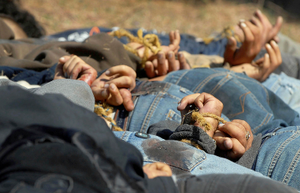Mexico: descent into chaosMexican war toll: 34,612 drug-war deaths in four years
A total of 34,612 people have died in drug-related killings in Mexico since December 2006; the four-year figure included 30,913 execution-style killings, 3,153 deaths in shootouts between gangs, and 546 deaths involving attacks on authorities; the killings reached their highest level in 2010, jumping by almost 60 percent to 15,273 deaths from 9,616 the previous year

Some of the 34,000-plus casualties // Source: nocaptionneeded.com
A total of 34,612 people have died in drug-related killings in Mexico in the four years since Mexican president Felipe Calderon declared an offensive against drug cartels, officials said Wednesday.
The killings reached their highest level in 2010, jumping by almost 60 percent to 15,273 deaths from 9,616 the previous year.
The rate of killings grew in the first half of 2010, but then stabilized and began to decline in the last quarter of the year, federal security spokesman Alejandro Poire said.
Calderon said Wednesday that 2010 “has been a year of extreme violence.”
“We are aware that we are going through a very difficult time on security issues,” he said at a meeting with anti-crime groups during which the government presented a new data system to track drug-related crimes.
AFP reports that anti-crime groups have long demanded access to information like that contained in the new database, to better measure whether public security efforts are effective. Such information may also help diminish the doubt that surrounds drug-related killings, many of which go unresolved or get scant investigation in Mexico.
Poire’s office said the four-year figure included 30,913 execution-style killings, 3,153 deaths in shootouts between gangs, and 546 deaths involving attacks on authorities.
The president launched an offensive against Mexico’s powerful drug cartels soon after taking office on 1 December 2006.
Calderon said many of the killings in 2010 were generated by the turf war between the Zetas drug gang and their former allies in the Gulf cartel. He and other officials noted that about half the killings took place in three northern states: Chihuahua, Sinaloa, and Tamaulipas. Mexico has thirty-one states plus the capital, Mexico City.
Poire said drug-related killings peaked in the third quarter of 2010 and declined by almost 11 percent in the fourth quarter.
Calderon noted that decline during his talk. “I do not rule out that it could go back up, but … I think it is important,” he said.
Calderon said Mexico’s 31 state governments must do more to deal with corruption in local police forces and to fight organized crime, and said the federal government was doing its part. He said army troops have been recruited to serve as state police officers in northern Nuevo Leon state, where killings have spiked this year.
Calderon’s interior secretary, Francisco Blake Mora, presented the new prototype of a national identity card — Mexico’s first — to be distributed to youths under eighteen in some states. Most Mexicans currently use their voter ID cards as identification, but the new cards will have better security measures, including digitalized fingerprints and iris images, to prevent criminals from using false IDs.
Also Wednesday, the Defense Department said soldiers had caught Rigoberto Andrade Renteria, an alleged operations leader for the La Familia cartel, in the northern border city of Tijuana over the weekend. He was found with almost 60 pounds (27 kilograms) of methamphetamines, it said.
The government had offered a reward of five million pesos ($415,000) for information leading to his arrest. The La Familia cartel is based in the western state of Michoacan, but apparently has ties with traffickers in northern border states.
